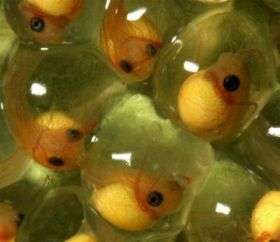Red-eyed treefrog embryos actively avoid asphyxiation inside their eggs

Boston University undergraduate Jessica Rogge and associate professor Karen Warkentin, working at the Smithsonian Tropical Research Institute's laboratories in Gamboa, Panama, discovered that frog embryos at a very early developmental stage actively respond to oxygen levels in the egg—as reported in the Nov. 7, 2008 issue of the Journal of Experimental Biology. These initial responses to the environment may be critical to the frogs' long-term survival.
Red-eyed treefrogs, Agalychnis callidryas, lay jelly-covered egg clutches on leaves overhanging tropical ponds. Each clutch of several dozen transparent eggs is ready to hatch after only four days. By delaying hatching by a few more days, frog embryos significantly increase their chances of survival as tadpoles in the pond below where predators lurk. But as each egg matures, and embryos need more oxygen, less and less of the vital substance is available inside.
Warkentin has measured oxygen levels as low as 2% air saturated in the middle of red-eyed treefrog eggs—yet the embryos refrain from hatching. "You'd think they would be dead. You'd think they would hatch. But they continue to develop at the same rate as embryos in eggs with much, much more oxygen," she explains. "Jessica found that these embryos maintain high metabolic rates and rapid, synchronous development by behaviorally positioning their external gills in a small high-oxygen area, a sweet spot near the exposed surface."
The team used a video camera to record embryo movement in the egg. By gently manipulating the eggs with a probe, Rogge turned the embryos within the eggs so that the gills were positioned away from the surface, in lower oxygen. "It's a lot like trying to pick something up out of a glass of water with your fingers," says Rogge, "the embryo 'wants' to be at the front of the egg, so unless I turned the embryo completely around in one motion it would come back to the front before I could finish spinning it."
Rogge found that even very young, neural-tube-stage embryos, before developing gills, blood, or the ability for muscular movement, kept their developing head in the oxygen sweet spot. "Once we started with the behavior research, it sort of snowballed and we suddenly got to the point where I spun the one-day-old embryos. We figured they would turn back, because they had ciliary rotation, but watching them ever so slowly return to the front, almost like clock-work, was amazing."
Rogge also induced embryos to lose their gills in the egg -- and was thus able to directly measure and compare the oxygen uptake ability of animals with and without gills, in eggs and in the water. "Embryos normally keep their external gills as long as they stay in the egg, but when they hatch they re-route the blood flow and the gills shrivel up in a matter of minutes" said Warkentin. "Now this makes sense. The external gills aren't much use to tadpoles, but they seem to be critical for embryos if they are to get enough oxygen."
People don't typically think of eggs as "doing" much. However, early development is a crucial time when death is a common occurance, and natural selection will favor any ability the embryo may have that increases its chances of survival.
Citation: Jessica R. Rogge and Karen M. Warkentin. 2008. External gills and adaptive embryo behavior facilitate synchronous development and hatching plasticity under respiratory constraint. The Journal of Experimental Biology, 211: 3627-3635 Now online doi: 10.1242/jeb.020958
Source: Smithsonian Tropical Research Institute
















